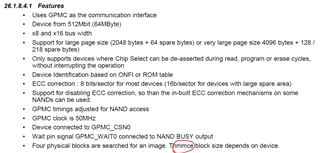#1. What is mean of "Thmmce" in NAND boot feature list?

#2. ROM support 4 backup boot image, and described how to find valid image header as below. if after finding a valid header, but encounter error bits more than 8/16 which can't be corrected, will it skip to next block or next sector to find next valid header? I assume it will, but did not find such description in TRM. below paragraph just telling how to find a valid header.
Page data can contain errors due to memory alteration. The ROM Code uses an ECC correction algorithm
to detect and possibly correct those errors. The ECC algorithm used is BCH with capability for correcting
8b or 16b errors per sector. The BCH data is automatically calculated by the GPMC on reading each 512
bytes sector. The computed ECC is compared against ECC stored in the spare area for the corresponding
page. Depending on the page size, the amount of ECC data bytes stored in the corresponding spare area
is different. Figure 26-20 and Figure 26-21 show the mapping of ECC data inside the spare area for
respectively 2KB-page and 4KB- page devices. If both ECC data are equal then the Read Sector function
returns the read 512 bytes sector without error. Otherwise the ROM Code tries to correct error(s) in the
corresponding sector (this procedure is assisted by the ELM hardware) and returns the data if successful.
If errors are uncorrectable, the function returns with FAIL.
When the 512-byte sector successfully passes the ECC check, the ROM checks for a valid configuration
header. A configuration header is considered to be valid if the first value (the Start field) contains data
other than 0x00000000 or 0xFFFFFFFF. If the Start field is not valid, the ROM reads the next 512-byte
sector, performs the ECC algorithm as described above, and checks for a valid configuration header. This
process is repeated for the whole block until a valid header is found. If a valid header is not found in the
first block, the ROM attempts the same process in the next block. For NAND, the ROM checks for a valid
header in the first four blocks. If no valid header is found in the first 4 blocks, the NAND boot fails, and the
ROM moves on to the next valid boot source as dictated by the SYSBOOT configuration signals.

